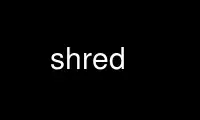
This is the command shred that can be run in the OnWorks free hosting provider using one of our multiple free online workstations such as Ubuntu Online, Fedora Online, Windows online emulator or MAC OS online emulator
PROGRAM:
NAME
shred - overwrite a file to hide its contents, and optionally delete it
SYNOPSIS
shred [OPTION]... FILE...
DESCRIPTION
Overwrite the specified FILE(s) repeatedly, in order to make it harder for even very
expensive hardware probing to recover the data.
If FILE is -, shred standard output.
Mandatory arguments to long options are mandatory for short options too.
-f, --force
change permissions to allow writing if necessary
-n, --iterations=N
overwrite N times instead of the default (3)
--random-source=FILE
get random bytes from FILE
-s, --size=N
shred this many bytes (suffixes like K, M, G accepted)
-u truncate and remove file after overwriting
--remove[=HOW]
like -u but give control on HOW to delete; See below
-v, --verbose
show progress
-x, --exact
do not round file sizes up to the next full block;
this is the default for non-regular files
-z, --zero
add a final overwrite with zeros to hide shredding
--help display this help and exit
--version
output version information and exit
Delete FILE(s) if --remove (-u) is specified. The default is not to remove the files
because it is common to operate on device files like /dev/hda, and those files usually
should not be removed. The optional HOW parameter indicates how to remove a directory
entry: 'unlink' => use a standard unlink call. 'wipe' => also first obfuscate bytes in
the name. 'wipesync' => also sync each obfuscated byte to disk. The default mode is
'wipesync', but note it can be expensive.
CAUTION: Note that shred relies on a very important assumption: that the file system
overwrites data in place. This is the traditional way to do things, but many modern file
system designs do not satisfy this assumption. The following are examples of file systems
on which shred is not effective, or is not guaranteed to be effective in all file system
modes:
* log-structured or journaled file systems, such as those supplied with AIX and Solaris
(and JFS, ReiserFS, XFS, Ext3, etc.)
* file systems that write redundant data and carry on even if some writes fail, such as
RAID-based file systems
* file systems that make snapshots, such as Network Appliance's NFS server
* file systems that cache in temporary locations, such as NFS version 3 clients
* compressed file systems
In the case of ext3 file systems, the above disclaimer applies (and shred is thus of
limited effectiveness) only in data=journal mode, which journals file data in addition to
just metadata. In both the data=ordered (default) and data=writeback modes, shred works
as usual. Ext3 journaling modes can be changed by adding the data=something option to the
mount options for a particular file system in the /etc/fstab file, as documented in the
mount man page (man mount).
In addition, file system backups and remote mirrors may contain copies of the file that
cannot be removed, and that will allow a shredded file to be recovered later.
Use shred online using onworks.net services
